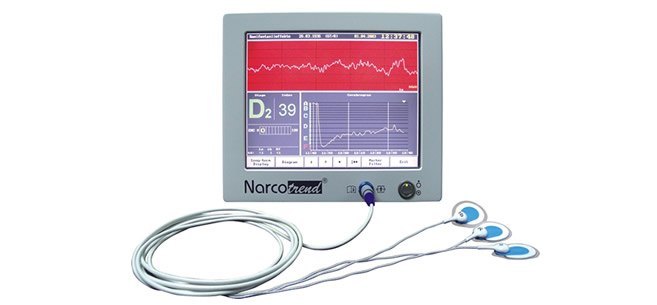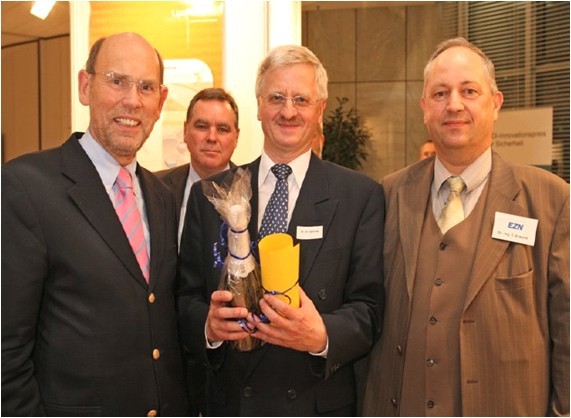Narcotrend EEG Monitor

-
Introduction -
Application and principle -
Related literature -
Clinical Cases -
Training Center
Golden Join Group is the only general agent in China of Narcotrend EEG Monitor for depth of anaesthesia.
Certificates:FDA, CE, SFDA and ISO
>《Innovation project》certificate from European Union
> The German invention Center conferred the “Over the past 30 years the most outstanding innovation award”
> Have been chosen as “Best Practice Award” by European Union in 2010

The founder of Narcotrend EEG System for monitoring depth of anaesthesia
.jpg) Narcotrend EEG System for monitoring depth of anaesthesia/sedation, developed by a research group of Hannover Medical School is a new kind of EEG monitor. Collecting EEG signal from any position of bead through common electrode, Narcotrend classify signal automatically and display patient’s anesthesia/consciousness status in colorful LCD, and instruct individual dosage of anesthetic/sedation, which makes depth of anesthesia/consciousness monitoring is more accurate, safe, simple and economical. So that it is able to monitor general operations such as craniotomy operation, burning operation, eye operation, hearing disorder operation etc.
Narcotrend EEG System for monitoring depth of anaesthesia/sedation, developed by a research group of Hannover Medical School is a new kind of EEG monitor. Collecting EEG signal from any position of bead through common electrode, Narcotrend classify signal automatically and display patient’s anesthesia/consciousness status in colorful LCD, and instruct individual dosage of anesthetic/sedation, which makes depth of anesthesia/consciousness monitoring is more accurate, safe, simple and economical. So that it is able to monitor general operations such as craniotomy operation, burning operation, eye operation, hearing disorder operation etc.
EEG signal is the comprehensive reflection of the cerebral cortex nerve cells synaptic potentials, it has the advantage and characteristic of reaction activity of consciousness and non-invasive. This is the most effective method for monitoring depth of anaesthesia/sedation at present. Narcotrend can analyze and classify the EEG during anaesthesia/sedation automatically to show the depth of anaesthesia/sedation. This idea comes from the description of Loomis system on human EEG changing during sleep in 1937, they classify the changing of EEG into 5 levels of A-E. In 1981, Kugler expanded the system of Loomis, defined a number of substates and applied into the classification of EEG during anaesthesia/sedation. In 2000, Schultz and his team used the system with substates (6 states and 15 substates, A B0-2 C0-2 D0-2 E0-2 and F0-1) to analyze and visual grading the EEG during different Inhaled and intravenous anesthetics, and named them Narcotrend stages. After that, they developed Narcotrend EEG automatic grading system, and made it widely used in clinical practice. Research shows that the correlation between the original EEG visual grading and automatic grading is up to 98%.
A lot of literatures demonstrate that Narcotrend has unique techniques as follows:
> The only one can collect EEG signal from different position of head, with two-channel version it is able to monitor EEG actives of both hemispheres at the same time.
> The only one can use common electrode and reusable needle electrode to collect EEG signal and analyze depth of consciousness. The only depth of consciousness monitor which can be used in different operation ( such as craniotomy, burning, eyes operation etc.) and for different patients.
> The only one can analyze signal automatically according to patients’ age and instruct dosage of medicine accurately.
• Haensch K, Schultz A, Kraub T, Grouven U, Schultz B. Women need more propofol than men during EEG - monitored total intravenous anaesthesia Biomed Tech 2009; 54: 76-82
• Weber F, Hollnberger H, Weber J. Electroencephalographic Narcotrend Index monitoring during procedural sedation and analgesia in children Pediatr Anesth 2008; 18: 823-830
• Panousis P, Heller AR, Burghardt M, Bleyl JU, Koch T. The effects of electromyographic activity on the accuracy of the Narcotrend monitor compared with the Bispectral Index during combined anaesthesia. Anesthesia 2007; 62: 868-874
• Schultz B, Büttner NA, Schonberg G, Bezler C,Schultz A. EEG - gestützte Narkoseüberwachung : Untersuchung hinsichtl-ich einer EEG - adaptierten Propofoldosierung. Klin Neurophysiol 2006; 37: 1-5
• Hardt T, Dressler I, Fritzsche T, Spies C, Rundshagen I. EEG versus non-EEG controlled anesthesia: does it make adifference? Anesthesiology 2005; 103: A52
• Bruhn J, Kreuer S, Hoeft A, Wilhelm W. Narcotrend Index versus bispectral index as EEG measures of anesthetic drug effect during isoflurane anesthesia. Anesthesiology 2003; 99: A338
• Kreuer S, Wilhelm W, Larsen R and the Narcotrend Study Group. Narcotrend - EEG - monitoring facilitates faster emergence after propofol anaesthesia: a multicenter study in 4630 patients. Eur J Anaesth 2002; 18 (Suppl 24):24
• Kreuer S, Wilhelm W, Biedler A, Brün K, Schoth S, Altman S, Larsen R. Altersabhangigkeit des Propofol-Verbrauchs bei Uberwachung des Narkose-EEG mittels Narcotrend-Analyse. Anasthesiol Intensivmed 2001; 42: 470
• Raymondos K., Piepenbrock S., Hausdorfer J., Panning B. Grouven U. Automatic EEG classification with Narcotrend into general stages of anaesthesia during remifentanil / propofol TIVA in elective inpatient surgery. Eur J Anaesth 2000; 17 (Suppl 19): 22
• Büttner N, Schultz B, Grouven U, Schultz A. EEG - adaptierte "target - controlled infusion" - Propofolzielkonz - entration bei unterschied Remifentanildosierungen Anaesthesist 2010; 59: 126-134
• Bauerle K, Greim CA, Schroth M, Geisselbrecht M, Kobler A, Roewer N. Prediction of depth of sedation and anaesthesia by the Narcotrend EEG monitor. Br J Anaesth 2004; 92: 841-845
1. In a laparoscopic surgery, a learning doctor followed up this surgery. At first anaesthesia is steady, Narcotrend stage D2, index 42, HR 78, BP 105/60mmHg. As it is need to push air to abdomen, after a while, BP increased, systolic BP to 175. Doctor thought that anaesthetic dosage was not enough, so he decided to increase the dosage, and caused too deep anaesthesia. And Narcotrend stage is F0, index is 12. Narcotrend showed that the depth of anaesthesia is too deep, it may be caused by operation stimulation (hemodynamics of abdominal aortic) Is it suitable to reduce BP by anaesthetics?
After Head doctor knew the situation, he analyzed: Because of pushing air to abdomen, pressing abdominal aortic and causing excitability such as hemodynamis increasing etc. then BP increased rapidly, at the same time Narcotrend showed that the depth of anaesthesia was suitable, if continued increasing anaesthetics, would cause too deep anaesthesia. It should be given antihypertensive drugs to control the BP in the suitable range.
Summary: Narcotrend can accurately monitoring depth of anaesthesia, prompt the anaesthetists to use suitable plan and drug, show the right way to the young doctors.
2. During a thoracic operation, a young doctor used desflurane and propofol to induce fast. Because of fast induce, it is used to increase inhalation at the beginning, and then the inhalation should be reduced after induce finished and turn into operation. However, the doctor forgot to turn down volatility pot and reduce inhalation, so Narcotrend indicated anesthesia depth F0, anesthesia too deep. That doctor remembered he operated it normally without mistake, and he doubted the equipment is not accurate. So he asked the management professor to observe and judge, after checking, the professor thought the equipment is normal, then he checked the TCI infusion and volatility pot and found the problem,. After adjusting inhalation normally, Narcotrned index rise and classification keep in E0. The young doctor was surprised. This operation proves the high accuracy of Narcotrend again.
Conclusion of doctor: Narcotrend can monitor depth of anesthesia accurately and help doctors to discover inappropriate operation during anesthesia, and even help to find other equipments work normally or not.
It proves that Narcotrend can instruct to use anesthetic evidently. Blood pressure is too low is not caused by deep anesthesia, but caused by shortage blood volume of the patient. Then colloids can be supplemented to patient to maintain normal blood pressure, so that to get accurate anesthesia.
3. Narration of a professor: a postgraduate was carrying on a gastric carcinoma operation, he tried to reduce dosage of anesthetic to maintain blood pressure. But the patient hadn’t have food for about two days before operation, which made blood pressure was too low during operation and the RR SYST was only a little more than 50. When that postgraduate reducing dosage of anesthetic, blood pressure increased a little but not evidently, but Narcotrend classification rise from D to C, anesthesia was too light.
.jpg)
Since gained the SFDA in 2010, Narcotrend has been fully recognized and supported the Chinese Medical Association, many hospitals volume using Narcotrend. The Chinese society of Anesthesiology and Germany Hannover medical management group founded "Narcotrend Monitoring Depth of Anesthesia Technique Training Centre” in Ruijin Hospital, Shanghai Jiao Tong University School of Medicines, Peking Union Medical College Hospital, Guangdong General Hospital, Xijing Hospital, Tongji Hospital, Wuhan, HUMAN PROVINCIAL TUMOUR HOSPITAL, the First Hospital of Gannan Medical University. These centre train many anesthesiologists, and made many contributions for surgical safety.
.jpg)
Narcotrend Monitoring Depth of Consciousness/Anesthesia Technique Southern Training Centre
.jpg)
Narcotrend Monitoring Depth of Consciousness/Anesthesia Technique PUMCH Training Base hold by Chinese Society of Anesthesiology
.jpg)
Narcotrend Monitoring Depth of Anesthesia Technique Training Centre hold by Chinese Society of Anesthesiology
.jpg)
Narcotrend Monitoring Depth of Anesthesia Technique Training Centre hold by Chinese Society of Anesthesiology
——Tongji Hospital, Wuhan
.jpg)
Narcotrend Monitoring Depth of Anesthesia Technique Training Centre hold by Chinese Society of Anesthesiology
—— the First Hospital of Gannan Medical University
.jpg)
Narcotrend Monitoring Depth of Anesthesia Technique Tumors Training Centre
——HUMAN PROVINCIAL TUMOUR HOSPITAL
.jpg)
